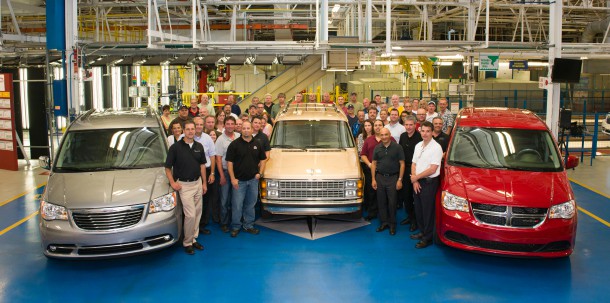Is Old-School Rebadging Dead?
Posted on Jun 15, 2014 in Editorials | 1 comment

So I got up behind a Dodge Grand Caravan the other day and I started thinking about my youth. This is because, in my youth, the Dodge Grand Caravan was an acceptable vehicle to drive, and not something you were stuck with when Enterprise ran out of full-size sedans.
There are two reasons for this: 1. Back in the day, the Dodge Caravan didn’t really have any competitors, so we didn’t really know that there were better options out there. Honda had the hinged-door Odyssey. Toyota had the weird-ass Previa. It was a mess; more importantly, 2. There were so many different versions of the Dodge Caravan that you were pretty much stuck buying a Dodge Caravan even if you actively avoided buying a Dodge Caravan.
The funny thing is that back then they all looked identical. Sure, there were some color changes here and some wheel updates there, but they were the same van. Even as a young child, this was clear to me. And it should’ve been clear to their drivers because there was a Chrysler Pentastar on the steering wheel no matter which one you had. These cars were so obviously rebadged clones of one another that they couldn’t be bothered to even change the horn pad to include every manufacturer’s logo. This was the really, really disappointing era of rebadging automobiles. (Also, Plymouth had no discernible logo at any time in my life. They never bothered to think one up.)
You don’t see this crap anymore. In fact, even though I’m young myself, I chuckle when I hear people my age or younger talking about “rebadges.” I heard the other day, for instance, that the Lexus ES is a “rebadged” Toyota Avalon. This is laughable. It’s like saying that central air conditioning is a rebadged ceiling fan.
Yes, the Avalon and the ES ride on the same platform and they share mechanicals. But my God, are these two cars not rebadged. Rebadging was when General Motors had four midsize sedans in the 1980s and literally slapped different badges on each one, while simultaneously changing things like the wheel covers and the shape of the head rests. The Avalon and ES are so different that even a small child could point them out in a parking lot. “That’s grandma’s car!” he would say.
In modern times, automakers don’t really do the rebadge thing anymore because they’ve discovered that most people are just too smart for it. Back in the 1990s, when there was no Internet, you kind of had to know your stuff to know that rebadging was going on. If you were a loyal Mercury guy and you went down to the Mercury dealer to get the latest thing, you weren’t necessarily aware that the Villager was just a Nissan Quest with different wheels. You probably thought Mercury was on to something with this cool new van.
But now, there’s no hiding a blatant rebadge, so automakers have generally stopped trying it. The only real exception I can think of is the Subaru BRZ and Scion FR-S, which are so pathetically rebadged that they even share the same wheels. Even during GM’s darkest rebadge days, even when the Taurus and the Sable shared everything but tail lights, even when the Dodge Spirit and the Plymouth Acclaim could only be distinguished by a glance at their rusting trunk lid, they always changed the wheels.
The funny thing about the BRZ and FR-S is — despite the fact that this is the most blatant, pathetic, disappointing, laughable automotive rebadge since the Mercury Tracer — everyone swears these two cars are different. Have you noticed this? Seriously. Ask a BRZ guy and he will swear up and down that the FR-S is worse. Ask an FR-S guy and he will pause his video game to swear up and down that the BRZ is worse. At the same time, the rest of us go around completely unsure which is which, afraid to offend people, sort of like anyone who enters a modern college campus.
But the BRZ and FR-S are outliers; unusual cars cut from an unusual cloth. The reality of today’s world is that the majority of “old school” rebadges are completely, totally, finished. Certain rebadge-heavy brands — like Mercury, Plymouth, and Pontiac — are gone. Model lineups have been re-tooled so they don’t all have the same products. And when an automaker does share platforms, they do it in a way that the vast majority of car shoppers are totally unaware of.
Well, there is one other exception, actually: the Dodge Grand Caravan and the Chrysler Town & Country. Not that it really matters when you’re picking it up from Enterprise.





You can tell that the legacy of old GM remains given their defense of the similarities between the chevy & GM pickup trucks – something along the line of “the trucks are 12% more different than the previous generation.”